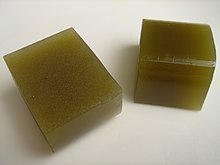Yōkan
 | |
| Type | Wagashi |
|---|---|
| Place of origin | Japan |
| Main ingredients | Agar,sugar,red bean pasteor white kidney bean paste |

Yōkan(Chè dương canh)is awagashi (Japanese confection)made ofred bean paste,agar,andsugar.It is usually sold in a block form, and eaten in slices. There are two main types:neri yōkanandmizu yōkan.Mizumeans "water", and indicates that it is made with more water than usual.Mizu yōkanis usually chilled and eaten in the summer, however inFukuiprefecture it is customarily eaten in winter.[1]
Types
[edit]Although yōkan found inJapanand abroad is typically made withred bean paste,yōkan made from white kidney bean paste(しろあん, bạch nhân,shiro an)is also relatively common. This type of yōkan is milky and translucent with a much milder flavour than that made of red bean paste. As such, it can be effectively flavoured and coloured by usinggreen tea powder.
Yōkan may also contain choppedchestnuts,[2]persimmons,whole sweetenedazuki beans,figs,andsweet potato(imo yōkan),among other additions. Sugar can also be replaced withhoney,darkbrown sugar,ormolassesto alter the taste of the yōkan produced. There is alsoshio yōkan,which uses small amounts ofsalt.
History
[edit]During theKamakura period(1185–1333), Japanese Buddhist monks who studied in theSong Dynastybrought the tea culture to Japan, and the custom of eating confections with tea began in Japan. The monks also introducedtenshin(Điểm tâm,dim sum),a light meal, and the history bookTeikin ōrai(Đình huấn lui tới)mentionsudon(饂 đồn),manjū(Màn thầu),andyōkan(Chè dương canh)astenshin(Điểm tâm).However, the manjū and yōkan brought to Japan by the monks were not sweets as we know them today, but were prepared in a completely different way.[3]Yōkan was a soup containing sheep meat, but since there was no custom of eating animal meat in Japan, the Japanese replaced the meat with a paste made of kneaded barley or azuki bean flour. Later, the soup was removed and replaced with a pasty confection made of barley or azuki bean flour. Finally, around 1800, during theEdo period(1603–1868), 500 years later, yōkan became what it is today. The invention ofkanten(Hàn thiên,agar)in the 1600s was essential to the birth of modern yokan. Later, the kanten invented in Japan was introduced to Manchuria, Korea and Taiwan.[4][5][6]
See also
[edit]References
[edit]- ^Sakiko Fujimura."Yokan—A Sweet that Evolved while Being Nurtured by Japan's Culture and Climate".
- ^Hạt dẻ chè dương canhat lục soát lục soát hỏi một chút wenwen.soso in Chinese
- ^駆け đủ でたどる cùng quả tử の lịch sử(in Japanese).National Diet Library.Archived fromthe originalon 22 February 2024.Retrieved22 February2024.
- ^そ の 1 cùng quả tử の lịch sử(in Japanese). Japan Wagashi Association. Archived fromthe originalon 22 February 2024.Retrieved22 February2024.
- ^Chè dương canh の lịch sử について(in Japanese). Kaiundo. 28 January 2019. Archived fromthe originalon 23 February 2024.Retrieved22 February2024.
- ^Hàn thiên(in Japanese). Digitalio, Inc. 8 April 2018. Archived fromthe originalon 23 February 2024.Retrieved22 February2024.
